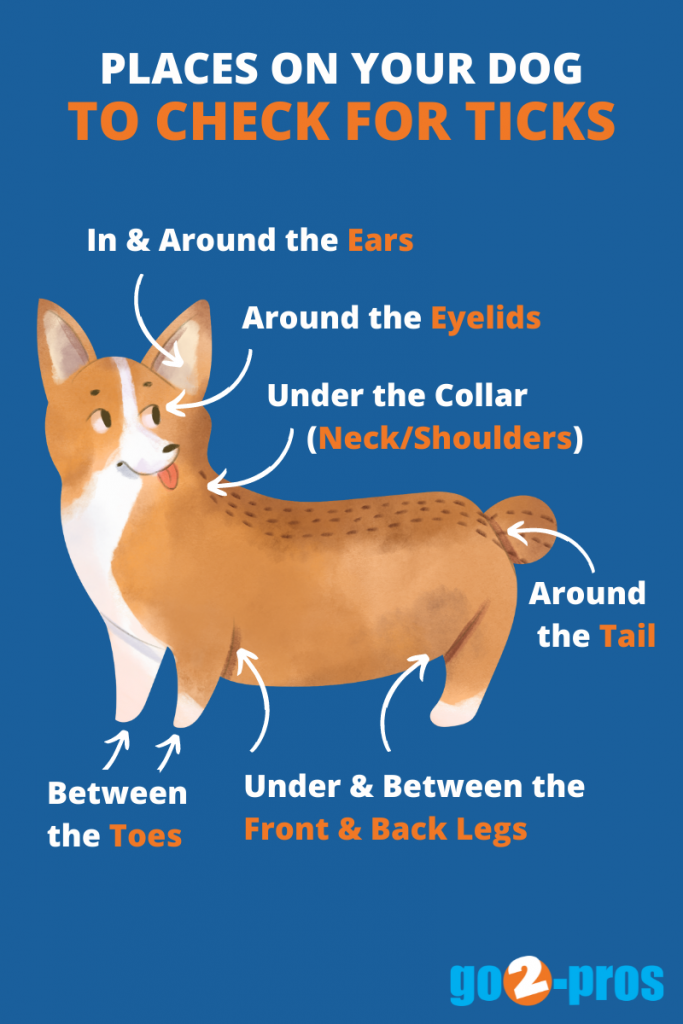How To Check Your Dog For Ticks

Tick season is upon us which means it’s time to start being more vigilant against these blood-thirsty pests. Unfortunately, humans aren’t the only ones who can be affected by ticks and the diseases they can pass on. Here’s how to check your dog for ticks to keep them safe this spring.
Why Ticks Are Such A Big Deal
Our 4-legged furry friends are also at risk of getting Lyme disease and Rocky Mountain spotted fever from tick bites. Both of these nasty diseases can cause stiffness, joint pain, and other health problems, in humans and pets.
It only takes a tick from 3-24 hours of feeding for a tick to infect an animal with disease. However, if you know how to find and remove them quickly, you can significantly lower the chances of your pet getting sick. You can also ensure your dog doesn’t accidentally bring these pests into your home, where they could attach themselves to you or other family members!
How To Check Your Dog For Ticks
Check your dog for ticks outside or just inside the doorway to your home, to lower the chance that a stray tick will get into the house and find its way to another host
Comb through your pet’s fur with your fingers, using gentle pressure to feel for any small bumps. Ticks can be as small as a pinhead or as big as a grape, with their size varying depending on species, age, and the amount of blood they’ve currently consumed.
As recommended by the CDC, thoroughly inspect your dog for ticks in the following areas:
- In and around the ears
- Around the eyelids
- Under the collar (if possible, take off the collar and inspect around the neck and shoulders)
- Under the front/back legs (where your pet’s “armpits” are)
- Between the back legs (the groin area)
- Between all toes (especially with breeds with webbed feet)
- Around/under the tail

If you feel a bump, part the fur so you can see the skin. Look for a black, brown, or greyish-brown bug. Depending on how long the tick has been attached, you may see the tick’s full body or you might only see its legs.
What to do if you find a tick on your dog
If you find a tick on your dog, don’t panic!
Here’s what you’ll need:
- latex/rubber gloves
- rubbing alcohol
- antibiotic ointment
- tweezers or a tick-removing tool
Note: Specific tick removal tools can be found at stores that sell pet or camping supplies and may be worth investing in if you live in an area like Ohio where ticks are rampant. These tools are better designed to help you remove the tick without accidentally leaving the head in the site of the bite!
Put the gloves on and locate the bug in your pet’s fur, separating the fur so that both skin and tick are exposed.
If you’re using tweezers, grab the tick as close as you can to the dog’s skin (without pinching your pooch, of course!) and carefully pull upward. Try to remove the tick in one fluid motion to avoid breaking a part of the tick’s body off and prevent the head from getting stuck in the skin.
If you have a tick-removal tool, follow the manufacturer’s instructions for how to use the device properly.
Put the tick in a glass jar, plastic bag, or something you can seal shut. Add about a teaspoon of rubbing alcohol to kill the tick. Seal the container and keep it for a few weeks. If your dog starts seeming ill within the coming weeks, take your pet and the tick to your vet. Your vet can examine the tick to see exactly what kind of tick it is, which can help them figure out how to treat your pet if the illness is related to the tick bite.
Clean around the site of the bite with rubbing alcohol and apply a bit of antibiotic ointment on the site to help prevent infection. Keep an eye on your dog in the days to come. If your pup begins displaying symptoms of tick-borne illness, bring them and the tick specimen into your vet ASAP. Also watch the site of where the tick was attached for infection. If the skin remains irritated, inflamed, or seems infected, make an appointment with your veterinarian.
Watch for symptoms
Here are a few of the more noticeable symptoms to watch for in regards to tick-related disease:
- stiff/swollen joints
- muscle pain
- fever
- excessive fatigue (lethargy)
- loss of appetite
- sudden neurological problems
- reluctance to move
- swollen lymph nodes
- vomiting
- diarrhea
How To Prevent Future Tick Bites
- If you and your dog spend a lot of time outdoors, especially in wooded, leafy or grassy areas, you should regularly be checking your pet for ticks.
- Ticks have a tendency to travel between hosts, too, so remember to check yourself and your other family members as well!
- Avoid letting your dog wander through tall grass
- Brush out your dog regularly with a fine toothed brush or comb
- Vacuum your home frequently to pick up any ticks that might fall off your pet
- Wash your pets bedding regularly, ideally once a week or every other week
- Talk to your vet about flea and tick preventatives
Worried about ticks and other pests around your home?
Contact go2-pros for more information on how to handle ticks and other pesky pests. Our expert exterminators are here to help you and your furry friends stay safe all summer long!
